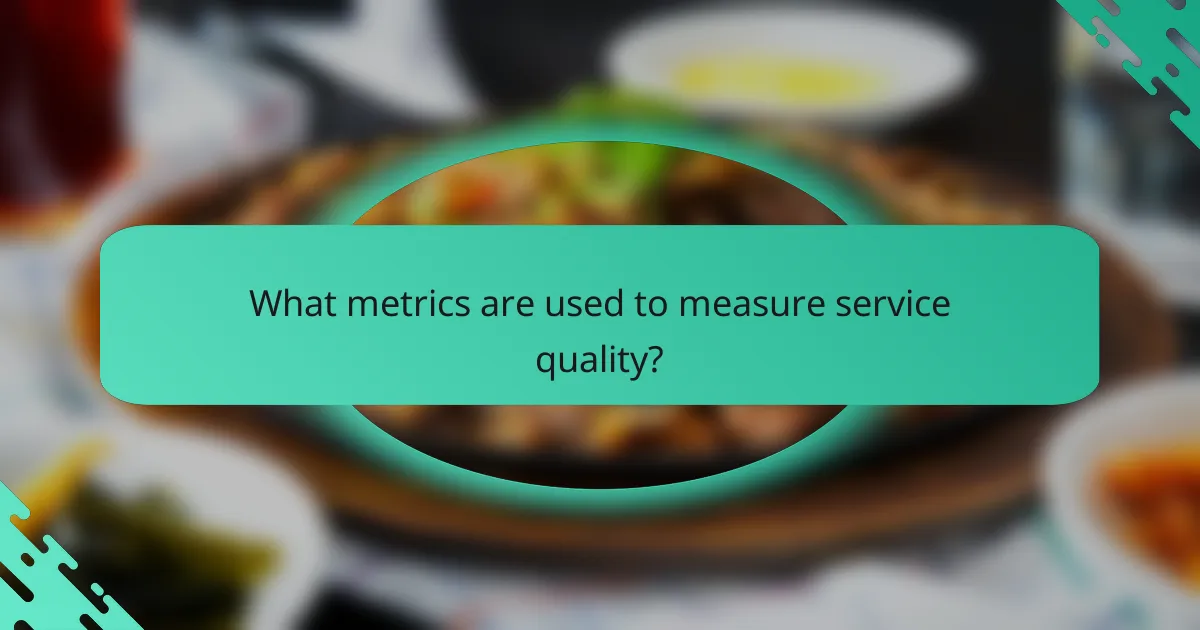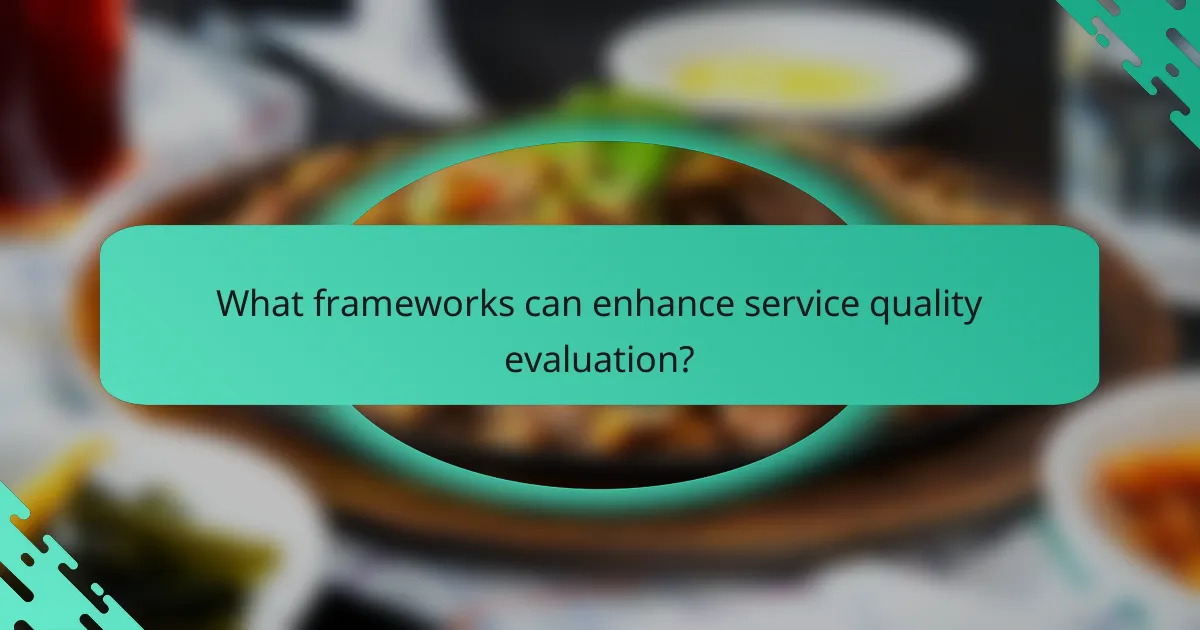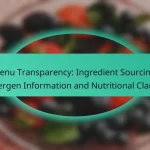Evaluating service quality is essential for local services, as it involves measuring customer satisfaction, performance metrics, and adherence to industry standards. By utilizing various evaluation methods and metrics, organizations can gain valuable insights into customer experiences and identify areas for improvement, ultimately enhancing service delivery and maintaining a competitive edge.

How to evaluate service quality in local services?
Evaluating service quality in local services involves assessing customer satisfaction, performance metrics, and compliance with industry standards. Effective evaluation methods provide insights into areas for improvement and help maintain competitive advantage.
Customer feedback surveys
Customer feedback surveys are a direct way to gather insights about service quality. These surveys can be conducted online, via phone, or in person, allowing customers to share their experiences and satisfaction levels.
To maximize response rates, keep surveys concise and focused on key aspects of the service. Consider using a mix of open-ended and closed questions to capture both quantitative and qualitative data.
Service performance metrics
Service performance metrics provide measurable indicators of service quality. Common metrics include response time, resolution time, and customer retention rates, which help identify strengths and weaknesses in service delivery.
Establish benchmarks for these metrics based on industry standards or historical data. Regularly review these metrics to track improvements or declines in service quality over time.
Benchmarking against industry standards
Benchmarking involves comparing your service quality against established industry standards or competitors. This process helps identify gaps in performance and areas where your service may fall short.
Utilize resources such as industry reports, customer reviews, and competitor analysis to inform your benchmarking efforts. Regularly update your benchmarks to reflect changes in industry expectations and customer preferences.
Net Promoter Score (NPS)
The Net Promoter Score (NPS) is a widely used metric that gauges customer loyalty and satisfaction. It is calculated by asking customers how likely they are to recommend your service to others on a scale from 0 to 10.
Customers are categorized as promoters, passives, or detractors based on their scores. A higher NPS indicates a stronger likelihood of customer referrals, which can drive growth and enhance service quality.
Service Level Agreements (SLAs)
Service Level Agreements (SLAs) are formal contracts that define the expected level of service between a provider and a customer. They outline specific performance metrics, response times, and responsibilities, ensuring accountability in service delivery.
Regularly review and update SLAs to reflect changes in service capabilities or customer expectations. Clear communication of SLAs to both staff and customers helps set realistic expectations and fosters trust.

What metrics are used to measure service quality?
Service quality is typically measured using a variety of metrics that provide insights into customer experiences and operational efficiency. Key metrics include customer satisfaction scores, response times, resolution times, employee engagement levels, and quality assurance evaluations.
Customer satisfaction score (CSAT)
The Customer Satisfaction Score (CSAT) gauges how satisfied customers are with a service or product. It is usually measured through surveys where customers rate their satisfaction on a scale, often from 1 to 5 or 1 to 10.
To effectively use CSAT, ensure that surveys are distributed shortly after service interactions to capture immediate feedback. Aim for a CSAT score above 80% to indicate strong customer satisfaction.
First response time
First response time measures how quickly a service team responds to a customer inquiry or issue. This metric is critical as it reflects the efficiency of customer support and can significantly impact customer satisfaction.
Best practices suggest aiming for a first response time of under 1 hour for email support and within a few minutes for live chat. Monitoring this metric helps identify bottlenecks in the support process.
Resolution time
Resolution time tracks the duration it takes to resolve a customer issue from the moment it is reported. This metric is vital for understanding the effectiveness of service processes and the overall customer experience.
To optimize resolution times, set clear benchmarks based on service type; for instance, aim for resolving simple issues within a few hours and more complex ones within 24 hours. Regularly review and adjust processes to improve efficiency.
Employee engagement levels
Employee engagement levels reflect how committed and motivated staff are in their roles, which directly influences service quality. Engaged employees are more likely to provide exceptional service and contribute positively to customer experiences.
To measure engagement, consider conducting regular employee surveys and feedback sessions. High engagement scores, typically above 70%, can correlate with better customer satisfaction and service outcomes.
Quality assurance evaluations
Quality assurance evaluations assess the consistency and quality of service delivery through structured reviews of customer interactions. This metric helps identify areas for improvement and ensures that service standards are met.
Implement regular quality assurance checks, such as call monitoring or ticket reviews, to maintain high service standards. Aim for a quality score of at least 90% to ensure that customer interactions meet established benchmarks.

What standards govern service quality in local services?
Service quality in local services is primarily governed by a combination of international standards, local regulations, industry best practices, and frameworks focused on customer service excellence. These standards ensure that services meet customer expectations and comply with legal requirements, enhancing overall satisfaction and trust.
ISO 9001 certification
ISO 9001 is an internationally recognized standard that outlines the criteria for a quality management system. Organizations that achieve this certification demonstrate their commitment to providing consistent quality in their services, which can lead to improved customer satisfaction and operational efficiency.
To obtain ISO 9001 certification, businesses must implement a quality management system that includes processes for continuous improvement and customer feedback. Regular audits are conducted to ensure compliance, and maintaining this certification can enhance a company’s reputation in the local market.
Local regulatory compliance
Local regulatory compliance involves adhering to laws and regulations specific to the region in which a service operates. These regulations can cover various aspects, including health and safety standards, consumer protection laws, and environmental regulations.
For example, a local restaurant must comply with health codes that dictate food safety practices, while a service provider may need to follow labor laws regarding employee treatment. Non-compliance can result in fines or legal action, making it crucial for businesses to stay informed about relevant regulations.
Industry-specific best practices
Industry-specific best practices are guidelines developed within particular sectors to enhance service quality. These practices often emerge from collective experiences and research, providing a framework for businesses to follow in order to meet customer expectations effectively.
For instance, in the hospitality industry, best practices may include personalized customer service and cleanliness standards. Adopting these practices can help businesses differentiate themselves and build a loyal customer base.
Customer service excellence frameworks
Customer service excellence frameworks provide structured approaches to delivering high-quality service. These frameworks often include principles such as responsiveness, empathy, and effective communication, which are essential for fostering positive customer interactions.
Implementing a customer service excellence framework can involve training staff, establishing clear service protocols, and regularly measuring customer satisfaction. Businesses that prioritize these frameworks often see improved customer loyalty and positive word-of-mouth referrals.

What frameworks can enhance service quality evaluation?
Frameworks that enhance service quality evaluation provide structured approaches to assess and improve service delivery. Utilizing established models helps organizations identify gaps, set benchmarks, and implement strategies for continuous improvement.
Service Quality Model (SERVQUAL)
The SERVQUAL model measures service quality by assessing the gap between customer expectations and perceptions across five dimensions: tangibles, reliability, responsiveness, assurance, and empathy. This framework allows businesses to pinpoint specific areas needing improvement.
To effectively use SERVQUAL, organizations should conduct surveys that ask customers to rate their expectations and experiences. A common approach is to use a Likert scale, where respondents indicate their level of agreement with various statements related to service quality.
Common pitfalls include failing to adapt the model to specific industries or neglecting to act on the feedback received. Regularly revisiting and updating the survey can help maintain relevance and accuracy.
Balanced Scorecard approach
The Balanced Scorecard approach evaluates service quality by integrating financial and non-financial performance metrics. It focuses on four perspectives: financial, customer, internal processes, and learning and growth, providing a comprehensive view of organizational performance.
Implementing the Balanced Scorecard involves defining key performance indicators (KPIs) for each perspective. For instance, customer satisfaction scores can be tracked alongside operational efficiency metrics to ensure a balanced view of service quality.
Organizations should ensure alignment between their strategic objectives and the metrics used in the Balanced Scorecard. Regular reviews and adjustments are crucial to adapt to changing market conditions and customer expectations.

How can technology improve service quality assessment?
Technology enhances service quality assessment by providing tools that streamline data collection, analysis, and reporting. These advancements enable organizations to gather real-time feedback, monitor performance metrics, and identify areas for improvement efficiently.
Customer relationship management (CRM) tools
CRM tools are essential for managing customer interactions and data throughout the service lifecycle. They help businesses track customer feedback, preferences, and behaviors, allowing for a more personalized service experience.
By utilizing CRM systems, companies can analyze customer interactions to identify trends and pain points. This data-driven approach enables businesses to make informed decisions that enhance service quality and customer satisfaction.
When selecting a CRM tool, consider features such as automation capabilities, integration with other systems, and user-friendliness. Popular options include Salesforce, HubSpot, and Zoho, which offer various pricing plans to suit different business sizes and needs.


